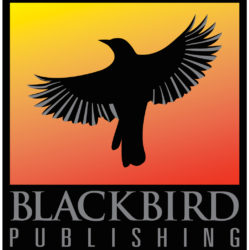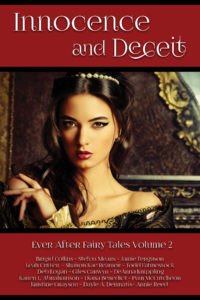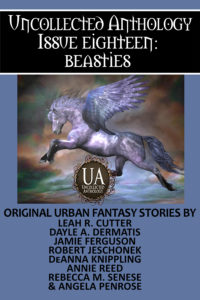“True Love (Or the Many Brides of Prince Charming)” is in Innocence and Deceit, the second volume in the Ever After Fairy Tales anthology series.
Enter the magical, unpredictable, wonderful world of fairy tales!
Meet Todd Fahnestock and Giles Carwyn!
Todd and Giles have been friends since high school. They co-wrote The Heartstone Trilogy, an epic fantasy that begins in the city-state of Ohndarien and includes murder, treachery, invasion, and the curse of a fallen city of sorcerers. Todd collects quotes, is fascinated by slang, and spends as much time as he can with his quirky, fun-loving family. Giles has worked as a film script analyst, and is currently focusing on writing screenplays.
“True Love (Or the Many Brides of Prince Charming”
Some people blame poor Prince Charming for throwing Cinderella into the dungeon, having little Snow White beheaded, and ordering Sleeping Beauty to be burned at the stake. But “True Love (or the Many Brides of Prince Charming)” tells us the other side of the story…
Excerpt
The glass slipper should have tipped him off. Cinderella’s odd carriage should have nailed the coffin shut on her chances of marriage. There were hints all along of trouble to come, but Charming was smitten. He could see nothing beyond her beauty, her soft skin, her fine figure. Her dulcimer voice haunted his memories.
But what kind of a woman owns glass shoes? Shoes in which the slightest misstep meant severe lacerations? What kind of a woman shuttled herself around in a squash? From the moment she stepped out of the coach, Charming should have realized she was out of her gourd.
With that damn slipper, Charming managed to find Cinderella. He and his entourage went door to door, searching for the owner of the glass slipper. When he found it fit upon the delicate foot of a servant girl he could not have been happier. Two days later he was married.
No one truly knows what occurred on the honeymoon. As honeymoons should be, it was an affair between the young lovers alone, but Charming returned with a smile on his lips and light in his eyes.
Things went downhill after that.
—from “True Love (Or the Many Brides of Prince Charming)” by Todd Fahnestock and Giles Carwyn
The Interview – Giles Carwyn
“True Love (Or the Many Brides of Prince Charming)” is a humorous take on Prince Charming and his brides Cinderella, Snow White, and Sleeping Beauty. What’s your favorite part about this story?
My favorite part of the True Love is the way it subverts expectations. The idea for the story came when I was on a blind date in college. My date asked, “Why did Cinderella, Sleeping Beauty, and Snow White all fall for Prince Charming? Don’t they all know that he is cheating on all of them.” My immediate urge was to flip her question around and paint Charming as the poor romantic fool who had been betrayed by each of the women. (Which my date thought was very funny, but not funny enough to want a second date.) That idea of the thrice married man being a victim rather than a player was the initial inspiration for the story Todd and I wrote.
Is there a fairy tale that you really enjoy, or which has stuck with you? If so, which one—and what do you find compelling about this particular story?
Of all the classic fairy tales, I find Beauty and the Beast the most compelling. That’s mostly because I’m a sucker for dancing spoons and Disney romances, but I also appreciate the deeper meaning of the story. I have heard an interpretation that the story is about women learning to love the animalistic parts of men and men’s sexuality and men learning to love women for who they are, not for what the can give you. People criticize the story for being a romanticization of Stockholm Syndrome (which it is) but on a deeper level I think it is about finding Beauty (humanity) within the Beast and the Beast (strength/value) within the Beauty.
The original fairy tales were often cautionary tales, told to teach lessons. Do you find some of these lessons still apply in today’s world?
I would say that all stories are cautionary tales. And I find it fascinating how humans keep updating our favorite old stories to address new things we need to be cautioned about. The way I see it, the “original” fairy tales were mostly focused on gaining wealth and status like marrying a prince in Cinderella or finding a great treasure in Aladdin. Then those stories were then rewritten in the 20th century with happy/romantic endings that were focused on gaining “true love” rather than wealth or status. More recently, as we have become more skeptical of the idea that kissing a super hot stranger will lead to lifelong happiness, the tales are getting rewritten again. More modern fairy tales like Shrek (which is focused on emotional intelligence and gentrification) and Wall-e (which is focused on isolation and environmental sustainability) are still cautionary tales, they are just cautioning about different things.
Giles, you’re working on a series of middle-grade books about children who find four magic hats. Other than the magical aspect, what’s special about these hats?
There are four children in the book. One experiences the world through his mind and tries to solve all his problems by being smart. One experiences the world through her emotions and tries to solve all her problems through relationships with other people. A third experiences the world through her body and tries to solve all her problems by being active and assertive. And the last experiences the world through his ideals and tries to solve all his problems by staying positive. All of them are struggling because their narrow approaches to life don’t work very well. Then they discover the magic hats which represent the four archetypes of the Lover, the Warrior, the Magician, and the Sovereign. Putting on different hats causes the wearer to start thinking different thoughts and feeling different feelings. That leads the children to discover and learn to appreciate the four different approaches to life: being smart, being connected, being assertive, or being positive. As each of the children learns the strengths and weaknesses of each approach, they become more confident and well-rounded people. And then… Of course… All hell breaks loose. The four of them need band together and use all their new skills to save the magical land that the hats came from.
What story (or stories) are you working on now, and what’s fun about what you’re writing?
These days I am focusing on screenplays. I’m in the middle of revising a King Arthur story that focus on Merlin and the Lady of the Lake’s relationship as they try to train an adolescent Arthur to become the king the Brittain needs. What’s fun about the story is that Merlin and Nimue have very different ideas of what makes a great king. Merlin has a very masculine approach. Nimue has a very feminine approach. And they fall in love as they argue about how to raise Arthur, who being a teenager, doesn’t want to listen to anything either of them say. .
I am also working a script called the Phantom of the O. It is a retelling of Phantom of the Opera set in a modern day New York City sex club. The heart of the story is taking a deeper look at the pressure, support, and judgments women put on each other around their sexuality. What I enjoy most about the story is the edgy, sexy and ultimately very heartfelt relationship between our heroine and the Phantom. He’s really cool, in a deeply broken kind of way.

The Interview – Todd Fahnestock
“True Love (Or the Many Brides of Prince Charming)” is a humorous take on Prince Charming and his brides Cinderella, Snow White, and Sleeping Beauty. What’s your favorite part about this story?
For me, it was the last part of Charming’s interaction with Sleeping Beauty, when her obsession with sharp things comes to a pointy crescendo of profanity. I always laugh aloud. Though where Giles started and I left off in the story is often fuzzy in my memory, I’m pretty sure he wrote that part, which is likely why it always makes me laugh.
Is there a fairy tale that you really enjoy, or which has stuck with you? If so, which one—and what do you find compelling about this particular story?
Interestingly, the “fairy tale” that has stuck in my mind forever was a novel based on the life of Sleeping Beauty. It was a fractured fairy tale, of sorts. The name of the book was Beauty, and for the life of me I can’t remember the author’s name, but the story followed Beauty from the original fairy tale into a harrowing journey to all kinds of places you wouldn’t associate with the character. It was a dark, apocalyptic fantasy of the past and the future, rife with diabolical faeries, time traveling psychopaths, and a horrific possible future ending of the world. Beauty is caught up in this nightmare, an object of desire for some pretty horrible men, and her character arc is one of strength, growth and perseverance. One of the most interesting characters is the faerie Puck, who alternately betrays Beauty and saves her life (which, I suppose, is in his job description, fickle fellow that he is). I read this in college many years ago, and I wish I could find a copy of it and read it again. It made an impression on me.
[Giles’s note: The book is Beauty by Sherri S. Tepper]
The original fairy tales were often cautionary tales, told to teach lessons. Do you find some of these lessons still apply in today’s world?
I do, though I think it depends on the particular faerie tale and the particular lesson. Some of them were pretty black and white morality plays, and we just don’t live in a black and white world anymore.
Todd, what is “slanglift,” and do you use any of the slang you come across in your writing?
Ha ha! I love the “slanglift” part of my website. It’s a composite of two of my great joys: language and teenagers. I love kids. I love to play with young kids, running around, making them laugh (one of my greatest inventions of all time is a game called Cake Monster, which has mostly to do with chasing kids around the yard), and I love listening to teenagers, with all the brilliant things their hyperactive minds produce. Sometimes, if I can get away with it, I’ll set my phone to voice recording while I’m taking my daughter Elo and her friends to a dance or back home from play practice, just to record the way they talk to one another. I’m fascinated by how quickly teen slang will come and go. A personality-defining phrase in 2018 will suddenly vanish in 2019. It reminds me that teenagers are in a time warp compared to me. A year of my life is like a brick stacked on a single tower I’ve been building for 49 years. A year of their lives, by comparison, is like a million bricks, forming dozens of little towers, an entire mini-civilization, a Rome that actually IS built in a day. And it can vanish just as quickly, these “towers” of their relationships, of their catch-phrases, falling into disuse within months. I love to capture these “eras” before they pass, immortalizing the ruins of their bygone teen parlance on my website.
What story (or stories) are you working on now, and what’s fun about what you’re writing?
Oh! Such a great question. I’m working on an epic fantasy novel called Brilliant. It’s a story about the inquisitive, sarcastic and romantic Brom, who attends the Champion’s Academy, a school of magic where all would-be magicians (called Quadrons in this world) must train. The school is run by a mysterious and nigh-omnipotent group known only as The Four, and as we follow Brom through his time at the school, we discover that The Four may not be as benevolent as they seem…
About Todd
Todd Fahnestock is a writer of fantasy for all ages. His bestselling The Wishing World series for middle grade readers began as bedtime stories for his children. His epic fantasy series include: Threadweavers, The Heartstone Trilogy and The Whisper Prince Trilogy. Charlie Fiction, a time travel urban fantasy, is his latest novel. Stories are his passion, but Todd’s greatest accomplishment is his quirky, fun-loving family. When he’s not writing, he goes on morning runs with his daughter, wrestles with his son, and practices Tae Kwon Do. With the rest of his free time, he drives the love of his life crazy with the emotional rollercoaster that is being a full time author.
Find Todd
Website ~ Facebook ~ BookBub ~ Amazon ~ Goodreads
About Giles
Giles Carwyn is a novelist, screenwriter, husband, father. He co-authored the Heartstone Trilogy with Todd Fahnestock published by Harper Collins in 2006-2008. While living in Los Angeles he worked as script analyst for Phoenix Pictures. He has presented workshops on various aspects of the writer’s craft through Pike’s Peak Writers and Delve Writers. His also a licensed Shadow Work® Facilitator and Coach who specializes in men’s sexuality. He is a co-creator of the Eros Work Program and the Men’s Sexual Shadow Transformation Weekend with Shadow Work® founder Cliff Barry. He currently lives in Asheville, NC and is working on a historical screenplay about the mentoring relationship between Merlin and the teenage King Arthur.
Find Giles
Find Innocence and Deceit!
Amazon ~ Barnes & Noble ~ Kobo ~ Apple Books ~ Books2Read ~ Goodreads




